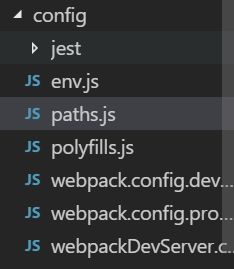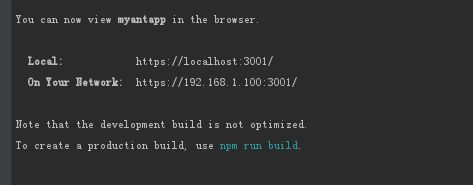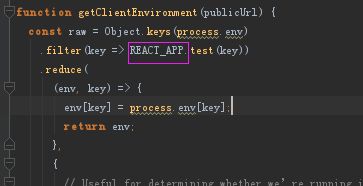React学习笔记_从create-react-app学习webpack
从create-react-app学习webpack
更多干货
分布式实战(干货)
spring cloud 实战(干货)
mybatis 实战(干货)
spring boot 实战(干货)
React 入门实战(干货)
构建中小型互联网企业架构(干货)
python 学习持续更新
ElasticSearch 笔记
kafka storm 实战 (干货)
scala 学习持续更新
RPC
1.没有配置的现代化构建
Create React App is a new officially supported way to create single-page React applications. It offers a modern build setup with no configuration.
链接地址:create-apps-with-no-configuration
利用create-react-app很快搭建出来了自己的项目,可以通过create-react-app来深入了解webpack
2.创建一个webpack的项目
如何用create-react-app构建一个webpack的项目
npm install -g create-react-app
//切记项目名称不能大写
create-react-app firstapp
cd firstapp
npm run start
3.查看create-react-app的配置文件
创建完一个项目之后,你会发现为什么没有配置文件呢. 这是需要运行
npm run eject复制出相关的配置文件 so,why is that? 来看一下官方的文档,
npm run eject Note: this is a one-way operation. Once you eject, you can’t go back! If you aren’t satisfied with the build tool and configuration choices, you can eject at any time. This command will remove the single build dependency from your project. Instead, it will copy all the configuration files and the transitive dependencies (Webpack, Babel, ESLint, etc) right into your project so you have full control over them. All of the commands except eject will still work, but they will point to the copied scripts so you can tweak them. At this point you’re on your own. You don’t have to ever use eject. The curated feature set is suitable for small and middle deployments, and you shouldn’t feel obligated to use this feature. However we understand that this tool wouldn’t be useful if you couldn’t customize it when you are ready for it.
看了这两段,我们首先可以看出来 npm run eject 是一个'一次性操作',只能使用一次.
一、package.json 详解
先不看配置目录,先看看create-react-app 构建出来的项目用了哪些依赖.
"dependencies": {
//一个为了兼容浏览器,为样式自动添加前缀的库
"autoprefixer": "7.1.6",
//babel es6->es5
"babel-core": "6.26.0",
"babel-eslint": "7.2.3",
"babel-jest": "20.0.3",
"babel-loader": "7.1.2",
"babel-preset-react-app": "^3.1.0",
"babel-runtime": "6.26.0",
//对于这个插件不是很了解,简单看了一下文档,应该是为了兼容引入插件时的路径问题。
"case-sensitive-paths-webpack-plugin": "2.1.1",
"chalk": "1.1.3",
//css引入插件,将css装载到JavaScript例如 import './index.css'
"css-loader": "0.28.7",
//env 处理
"dotenv": "4.0.0",
//当你运行或者构建的时候,可以检查语法的库。我只能说这个库非常有用,
//毕竟有时候除了error致命,warning也非常致命(如果你不注意的话)
"eslint": "4.10.0",
"eslint-config-react-app": "^2.0.1",
"eslint-loader": "1.9.0",
"eslint-plugin-flowtype": "2.39.1",
"eslint-plugin-import": "2.8.0",
"eslint-plugin-jsx-a11y": "5.1.1",
"eslint-plugin-react": "7.4.0",
//css 打包插件
"extract-text-webpack-plugin": "3.0.2",
//文件加载打包插件包括图片,js文件等
"file-loader": "1.1.5",
//文件系统扩展模块
"fs-extra": "3.0.1",
//html生成插件,可以自动引入css和js
"html-webpack-plugin": "2.29.0",
//单元测试工具
"jest": "20.0.4",
//目测应该是Object.assign()的兼容库---不懂。。。
"object-assign": "4.1.1",
//一种用于修复flexbug的bug的插件。
"postcss-flexbugs-fixes": "3.2.0",
//css构建中,浏览器兼容库
"postcss-loader": "2.0.8",
//promise库
"promise": "8.0.1",
"raf": "3.4.0",
//内置react相关库
"react": "^16.1.1",
"react-dev-utils": "^4.2.1",
"react-dom": "^16.1.1",
//样式加载库,使JavaScript认识css
"style-loader": "0.19.0",
//不是很了解,搜了一下应该提供一种web前端的缓存方案的库
"sw-precache-webpack-plugin": "0.11.4",
//css和dom属性中 的各种文件引入
"url-loader": "0.6.2",
//webpack
"webpack": "3.8.1",
"webpack-dev-server": "2.9.4",
"webpack-manifest-plugin": "1.3.2",
//fetch 请求,一种更加优雅异步加载的请求方式
"whatwg-fetch": "2.0.3"
}
--env.js
返回客户端的环境配置
--paths.js
返回各种项目关键的目录位置
--polufills.js
引入promise,fetch,object.assign三种常用方法。
--webpack.config.dev.js
webpack开发环境配置文件
--webpack.config.prod.js
webpack生产环境配置文件
--webpackDevServer.config.js
小型的Node.js Express服务器
二、配置文件 env.js
'use strict';
const fs = require('fs');
const path = require('path');
const paths = require('./paths');
// Make sure that including paths.js after env.js will read .env variables.
delete require.cache[require.resolve('./paths')];
const NODE_ENV = process.env.NODE_ENV;
if (!NODE_ENV) {
throw new Error(
'The NODE_ENV environment variable is required but was not specified.'
);
}
// https://github.com/bkeepers/dotenv#what-other-env-files-can-i-use
var dotenvFiles = [
`${paths.dotenv}.${NODE_ENV}.local`,
`${paths.dotenv}.${NODE_ENV}`,
// Don't include `.env.local` for `test` environment
// since normally you expect tests to produce the same
// results for everyone
NODE_ENV !== 'test' && `${paths.dotenv}.local`,
paths.dotenv,
].filter(Boolean);
// Load environment variables from .env* files. Suppress warnings using silent
// if this file is missing. dotenv will never modify any environment variables
// that have already been set.
// https://github.com/motdotla/dotenv
dotenvFiles.forEach(dotenvFile => {
if (fs.existsSync(dotenvFile)) {
require('dotenv').config({
path: dotenvFile,
});
}
});
// We support resolving modules according to `NODE_PATH`.
// This lets you use absolute paths in imports inside large monorepos:
// https://github.com/facebookincubator/create-react-app/issues/253.
// It works similar to `NODE_PATH` in Node itself:
// https://nodejs.org/api/modules.html#modules_loading_from_the_global_folders
// Note that unlike in Node, only *relative* paths from `NODE_PATH` are honored.
// Otherwise, we risk importing Node.js core modules into an app instead of Webpack shims.
// https://github.com/facebookincubator/create-react-app/issues/1023#issuecomment-265344421
// We also resolve them to make sure all tools using them work consistently.
const appDirectory = fs.realpathSync(process.cwd());
process.env.NODE_PATH = (process.env.NODE_PATH || '')
.split(path.delimiter)
.filter(folder => folder && !path.isAbsolute(folder))
.map(folder => path.resolve(appDirectory, folder))
.join(path.delimiter);
// Grab NODE_ENV and REACT_APP_* environment variables and prepare them to be
// injected into the application via DefinePlugin in Webpack configuration.
const REACT_APP = /^REACT_APP_/i;
function getClientEnvironment(publicUrl) {
const raw = Object.keys(process.env)
.filter(key => REACT_APP.test(key))
.reduce(
(env, key) => {
env[key] = process.env[key];
return env;
},
{
// Useful for determining whether we’re running in production mode.
// Most importantly, it switches React into the correct mode.
NODE_ENV: process.env.NODE_ENV || 'development',
// Useful for resolving the correct path to static assets in `public`.
// For example,  .
// This should only be used as an escape hatch. Normally you would put
// images into the `src` and `import` them in code to get their paths.
PUBLIC_URL: publicUrl,
}
);
// Stringify all values so we can feed into Webpack DefinePlugin
const stringified = {
'process.env': Object.keys(raw).reduce((env, key) => {
env[key] = JSON.stringify(raw[key]);
return env;
}, {}),
};
return { raw, stringified };
}
module.exports = getClientEnvironment;
.
// This should only be used as an escape hatch. Normally you would put
// images into the `src` and `import` them in code to get their paths.
PUBLIC_URL: publicUrl,
}
);
// Stringify all values so we can feed into Webpack DefinePlugin
const stringified = {
'process.env': Object.keys(raw).reduce((env, key) => {
env[key] = JSON.stringify(raw[key]);
return env;
}, {}),
};
return { raw, stringified };
}
module.exports = getClientEnvironment;
首先明确env.js的主要目的在于读取env配置文件并将env的配置信息给到全局变量process.env
1.配置文件的优先级问题
### What other `.env` files can be used?
>Note: this feature is **available with `[email protected]` and higher**.
* `.env`: Default.
* `.env.local`: Local overrides. **This file is loaded for all environments except test.**
* `.env.development`, `.env.test`, `.env.production`: Environment-specific settings.
* `.env.development.local`, `.env.test.local`, `.env.production.local`: Local overrides of environment-specific settings.
Files on the left have more priority than files on the right:
* `npm start`: `.env.development.local`, `.env.development`, `.env.local`, `.env`
* `npm run build`: `.env.production.local`, `.env.production`, `.env.local`, `.env`
* `npm test`: `.env.test.local`, `.env.test`, `.env` (note `.env.local` is missing)
通过打印加上代码的逻辑,我们不难看出 文档给出的env的file 路径符合实际 
2.env的常用方法,
1.启动协议,端口和地址的变更
// Tools like Cloud9 rely on this.
const DEFAULT_PORT = parseInt(process.env.PORT, 10) || 3000;
const HOST = process.env.HOST || '0.0.0.0';
// We attempt to use the default port but if it is busy, we offer the user to
// run on a different port. `detect()` Promise resolves to the next free port.
choosePort(HOST, DEFAULT_PORT)
.then(port => {
if (port == null) {
// We have not found a port.
return;
}
const protocol = process.env.HTTPS === 'true' ? 'https' : 'http';
配置文件 .env.local
HTTPS=true
PORT=3001
3.项目相关key存储
.env还是很有用的.在项目开发上必然可能会使用到一些第三方平台的接口,那么在多人协同开发的时候,key的有效存储就很有必要 首先我们写下如下两个键值对
注意我们在定义一个全局变量的时候一定要注意以REACT_APP开头,当然如果哪些同学不是很满意这个设定,可以在env.js中去除filter.当然不是很推荐.
4.env的扩展使用想法
- 封装开发环境. 思路:封装 启动命令,读取指定env..读取指定配置文件,(有空再详细些)
- 静态资源的统一引入,在多人开发的时候.
三、path.js详解
'use strict';
const path = require('path');
const fs = require('fs');
const url = require('url');
// Make sure any symlinks in the project folder are resolved:
// https://github.com/facebookincubator/create-react-app/issues/637
const appDirectory = fs.realpathSync(process.cwd());
const resolveApp = relativePath => path.resolve(appDirectory, relativePath);
const envPublicUrl = process.env.PUBLIC_URL;
function ensureSlash(path, needsSlash) {
const hasSlash = path.endsWith('/');
if (hasSlash && !needsSlash) {
return path.substr(path, path.length - 1);
} else if (!hasSlash && needsSlash) {
return `${path}/`;
} else {
return path;
}
}
const getPublicUrl = appPackageJson =>
envPublicUrl || require(appPackageJson).homepage;
// We use `PUBLIC_URL` environment variable or "homepage" field to infer
// "public path" at which the app is served.
// Webpack needs to know it to put the right



